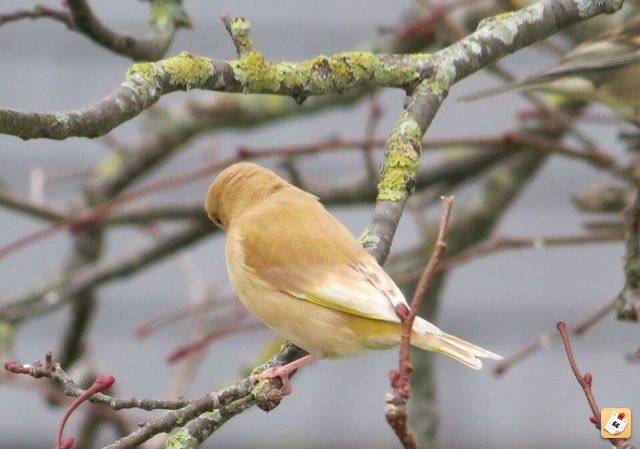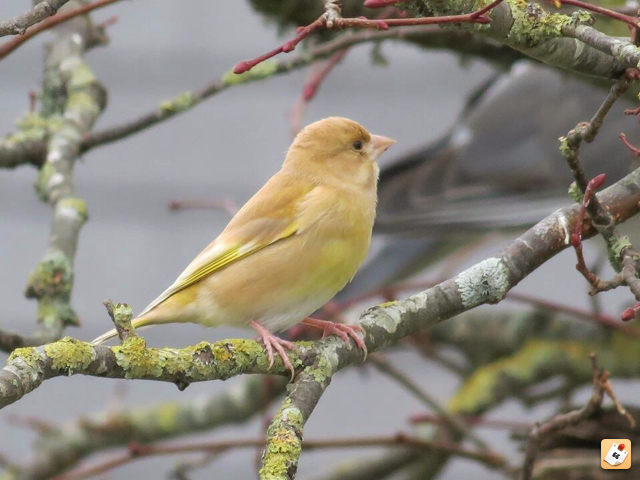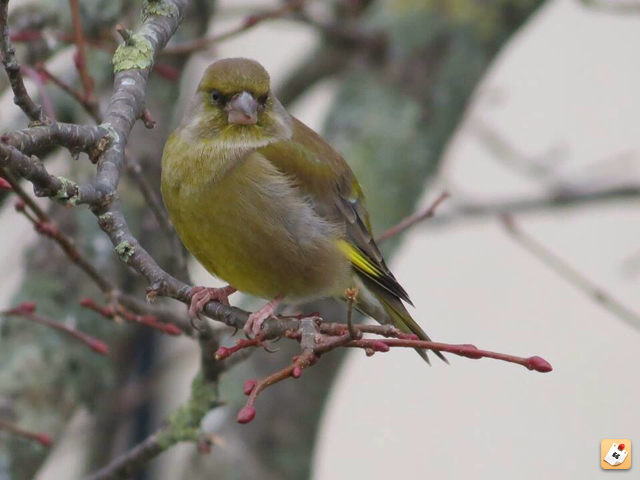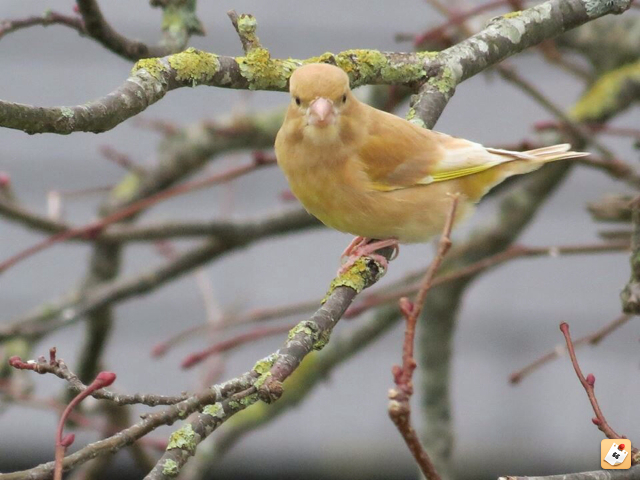-
Welcome to BirdForum, the internet's largest birding community with thousands of members from all over the world. The forums are dedicated to wild birds, birding, binoculars and equipment and all that goes with it.
Please register for an account to take part in the discussions in the forum, post your pictures in the gallery and more.
You are using an out of date browser. It may not display this or other websites correctly.
You should upgrade or use an alternative browser.
You should upgrade or use an alternative browser.
Greenfinch (xanthochroism)?? (1 Viewer)
- Thread starter RE Birder
- Start date
More options
Who Replied?
http://en.wikipedia.org/wiki/Xanthochromism explains it but it seems to be from a north american perspective and Greenfinch is not directly mentioned. But it does say that it could also be due to diet.
PS, I never knew that engineers knew such long words, let alone spell them8-P B
PS, I never knew that engineers knew such long words, let alone spell them8-P B
stonechat1
New member
Looks like a brown mutation Greenfinch to me.
There are also brown House Finch, Siskins, Redpolls and other carduelide out there:
http://eichholzsaenger-luethorst.jimdo.com/vogelarten-im-verein/cardueliden-mutationen/
There are also brown House Finch, Siskins, Redpolls and other carduelide out there:
http://eichholzsaenger-luethorst.jimdo.com/vogelarten-im-verein/cardueliden-mutationen/
RE Birder
Birding not twitching
http://en.wikipedia.org/wiki/Xanthochromism explains it but it seems to be from a north american perspective and Greenfinch is not directly mentioned. But it does say that it could also be due to diet.
PS, I never knew that engineers knew such long words, let alone spell them8-P B
😆 gods corps...
RE Birder
Birding not twitching
The photographs can also be seen here, where the difference between the presumed xanthochroistic bird is easier to appreciate. But is it really xanthochoism? To me it just looks as though there's a lack of green pigment.
Not sure Jack, that's why I posted. Maybe your right?
Tiraya
San Diego CA

It isn't xanthochroism/xanthism because this is a lack of red pigment typically.
Your bird is lacking yellow/green so its different. I don't know the name for this but Schizochroism is a term referring to any pigment loss/absence so I'd go with this. Axanthism is the absence of yellow pigment (Think budgies, blue budgies are axanthistic as they lack yellow) so this is probably applicable also.
Your bird is lacking yellow/green so its different. I don't know the name for this but Schizochroism is a term referring to any pigment loss/absence so I'd go with this. Axanthism is the absence of yellow pigment (Think budgies, blue budgies are axanthistic as they lack yellow) so this is probably applicable also.
stonechat1
New member
The ignorance of some people is beyond belief.
The green color is "build" by yellow (lipochrome) x black/brown (melanin). If the bird is missing the black part in the melanin the leftover result is "brown".
See:
http://www.ariafromabirdcage.com/Color.htm
or
http://www.colourcanaries.co.uk/melanin_canaries.html
At the latter you can ask the experts, if you need another explanation.
The green color is "build" by yellow (lipochrome) x black/brown (melanin). If the bird is missing the black part in the melanin the leftover result is "brown".
See:
http://www.ariafromabirdcage.com/Color.htm
or
http://www.colourcanaries.co.uk/melanin_canaries.html
At the latter you can ask the experts, if you need another explanation.
RE Birder
Birding not twitching
The ignorance of some people is beyond belief.
The green color is "build" by yellow (lipochrome) x black/brown (melanin). If the bird is missing the black part in the melanin the leftover result is "brown".
See:
http://www.ariafromabirdcage.com/Color.htm
or
http://www.colourcanaries.co.uk/melanin_canaries.html
At the latter you can ask the experts, if you need another explanation.
So this can occur naturally in a wild state as opposed to just aviculture?
Cheers
Jan-Paul Charteris
Sussex birder and budding moth enthusiast
The ignorance of some people is beyond belief.
The green color is "build" by yellow (lipochrome) x black/brown (melanin). If the bird is missing the black part in the melanin the leftover result is "brown".
See:
http://www.ariafromabirdcage.com/Color.htm
or
http://www.colourcanaries.co.uk/melanin_canaries.html
At the latter you can ask the experts, if you need another explanation.
Yellow + black = green...ok, yes that's well known, but from that, green minus the black = brown? Doesn't quite add up, certainly not enough to warrant the word "ignorance" being thrown about, though in some examples leucism being fewer black pigments as opposed to complete lack of, will create a different effect
Lacking black pigmentation would normally be known as leucism surely. "Brown mutation" certainly sounds like the kind of term that would be more used in aviculture, rather than birding as RE Birder said, though yes, as you say, leucism in Greenfinches could leave the green parts brownish or indeed yellowish. Leucism would also explain the the normally dark grey/black bits of the wing and tail being whitish on this bird
Last edited:
stonechat1
New member
Jan-Paul, sorry for my poor English in thise case. I wish I would be fluent.
You forgot the ground -colour what is yellow in greenfinches and also siskins.
When the leftover is only yellow ground colour and the melanin overlay is brown (while black is absent) the result will be brownish. Or as named on the website "cinammon".
That´s what I "read" there.
From the bible of colour canary breeders ( I don´t breed them) "The Colour Canary - genetics - breeding - housing - exhibition ", p.167 by Norbert Schramm (http://www.amazon.de/Die-Farbenkanarien-Genetik-Haltung-Ausstellung/dp/3837068714) :
A rather amateurish translation. Hope you can unterstand it:
You forgot the ground -colour what is yellow in greenfinches and also siskins.
When the leftover is only yellow ground colour and the melanin overlay is brown (while black is absent) the result will be brownish. Or as named on the website "cinammon".
That´s what I "read" there.
From the bible of colour canary breeders ( I don´t breed them) "The Colour Canary - genetics - breeding - housing - exhibition ", p.167 by Norbert Schramm (http://www.amazon.de/Die-Farbenkanarien-Genetik-Haltung-Ausstellung/dp/3837068714) :
Source: http://www.farbenkanarien.homepage.t-online.de/fk/fk_home.htmAus Untersuchungen in anderen Tierklassen wissen wir, dass durch Mutation des für die Synthese des Melanins verantwortliche Gens (hier s+ genannt) aus dem ursprünglichen Schwarz nur noch Braun entsteht.
Das bedeutet, dass die Melaninvorstufen sich nicht vollständig bis zum Schwarz entwickeln, sondern diese Polymerisation bereits bei einer braunen Vorstufe beendet ist. Die so entstandenen braunen bis maximal dunkelbraunen Melanine werden in der Feder eingelagert. Schwarze Anteile im Gefieder werden nie gebildet.
A rather amateurish translation. Hope you can unterstand it:
We know from studies in other animal classes that by mutation in the gene responsible for the synthesis of melanin (here called s +) from the original black only brown develops.This means, that the melanin precursors do not fully develop until the black, but this polymerization is already finished with a brown preliminary stage. The brown to maximally dark-brown melanin, developed in such a way, are stored in the feather. Black portions in the plumage are never formed.

Jan-Paul, sorry for my poor English in thise case. I wish I would be fluent.
A rather amateurish translation. Hope you can unterstand it:
There is absolutely nothing wrong with you translation Roman, you shouldn't put yourself down:t:
Users who are viewing this thread
Total: 2 (members: 0, guests: 2)







